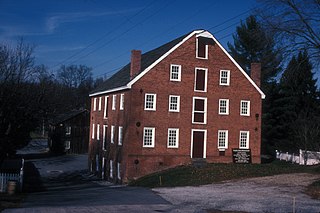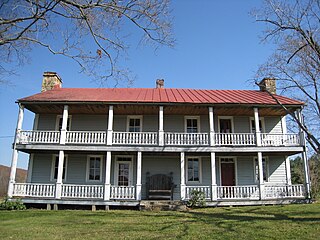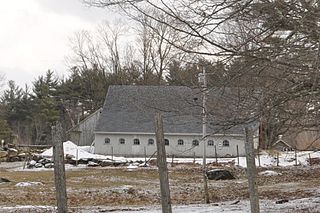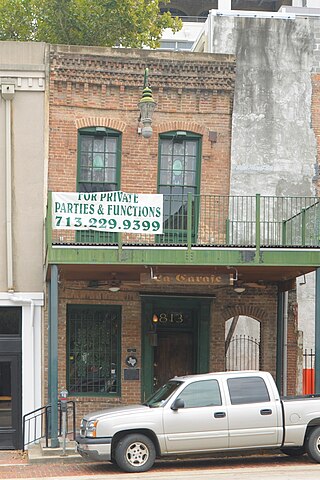
Jackson's Mill is a former grist mill in Lewis County, West Virginia, near the city of Weston. The mill, listed on the National Register of Historic Places in 1972, is now the centerpiece of a state-owned museum property. It is significant as a well-preserved early grist mill, and as the boyhood home of Stonewall Jackson, a prominent Confederate general in the American Civil War.

The Cyrus McCormick Farm and Workshop is on the family farm of inventor Cyrus Hall McCormick known as Walnut Grove. Cyrus Hall McCormick improved and patented the mechanical reaper, which eventually led to the creation of the combine harvester.

Kirby's Mill is a historic grist mill in Medford, Burlington County, New Jersey, United States. Originally known as Haines Mill, it was built in 1778 by Isaac Haines and partners along the Southwest Branch of Rancocas Creek. It was the last commercial operating mill in New Jersey.

Florence Mill, also known as the Weber Mill, is a historic mill located at 9102 North 30th Street near the 30th Street exit on I-680 in the Florence community in North Omaha, Nebraska. It was built in 1846 and operated into the 1960s. It was listed on the National Register of Historic Places as Weber Mill in 1998. The mill is also known as the Mormon Mill, Grist Mill, and Old Pink Mill. It is now operated as the Winter Quarters Mill Museum and ArtLoft Gallery.

The Stover Mill is a historic, American grist mill that is located in Erwinna, Bucks County, Pennsylvania.

The Tuthilltown Gristmill is located off Albany Post Road in Gardiner, New York, United States. It was built in 1788, as the National Register reports, and has been expanded several times since.

The Roslyn Grist Mill is located along Old Northern Boulevard in Roslyn, New York, United States. It was built sometime before the mid-18th century and is one of the few surviving Dutch colonial commercial frame buildings in the U.S. Added to the National Register of Historic Places in 1986, it is currently being restored for use as a museum.

George Washington's Gristmill was part of the original Mount Vernon plantation, constructed during the lifetime of the United States' first president. The original structure was destroyed about 1850. The Commonwealth of Virginia and the Mount Vernon Ladies’ Association have reconstructed the gristmill and the adjacent distillery. The reconstructed buildings are located at their original site three miles (4.8 km) west of the Mount Vernon mansion near Woodlawn Plantation in the Mont Vernon area of Fairfax County. Because the reconstructed buildings embody the distinctive characteristics of late eighteenth century methods of production and are of importance to the history of Virginia, the site is listed on the National Register of Historic Places despite the fact that the buildings are not original.

Union Mills Homestead Historic District is a national historic district at Westminster, Carroll County, Maryland, United States.

Hook's Tavern or Hook Tavern was a late 18th-century tavern along the Northwestern Turnpike east of Capon Bridge in Hampshire County, West Virginia. It was listed on the National Register of Historic Places on April 29, 2011. It burned in an alleged arson on October 14, 2022.

McCoy Mill is a historic grist mill on U.S. Highway 220, three miles south of Franklin, Pendleton County, West Virginia. It was built in 1845, and has a late 19th- to early 20th-century addition. It replaced a mill that operated on the site as early as 1766. It is a 2½-story, T-shaped frame building. General William McCoy (1768-1835) owned an earlier mill on the site.

Sugar Loaf Farm is an early 19th-century cluster of agricultural, industrial, and residential buildings located in a bucolic setting approximately 7.5 miles southwest of Staunton, Virginia and 1/2 mile southeast of Sugar Loaf Mountain. As a member of the U.S. National Register of Historic Places, Sugar Loaf Farm maintains the only surviving brick grist mill in Augusta County, Virginia. The brick grist mill on the property combines the mechanical principles of Oliver Evans, a prominent mill designer of the late eighteenth century, with the engineering craftsmanship and building detail of molded brick cornices, a vernacular architecture in the upper Shenandoah Valley in the early 1800s. The Farm's three original buildings, the farmhouse, grist mill and miller's house, were all constructed by David Summer at a time when Augusta County had emerged as the center of one of the most dominant wheat-growing and flour-processing regions in the South. Sugar Loaf Farm serves as a valuable reminder of the wheat-based agriculture that persisted in this region well into the twentieth century. Today, Sugar Loaf Farm is a privately run farm that specializes in raising Black Angus cattle.

Wallace-Cross Mill is a historic grist mill located at East Hopewell Township, York County, Pennsylvania. It was built in 1826, and is a 2 1/2-story, frame building on a stone foundation. It has a gable roof with decorative bargeboard. It has an 11 feet in diameter, 4 feet wide, steel water wheel to run the machinery. The mill was given to York County by its owner in 1979.

The Frost Farm is a historic farmstead on Korpi Road in Dublin, New Hampshire. It includes a farmhouse built in 1806 and subsequently enlarged, and a renovated 19th-century barn. The property is significant for its architecture, and for its ownership by both early settlers and later Finnish immigrants. A portion of the property was listed on the National Register of Historic Places in 1983.

The Lyme Center Historic District encompasses a modest crossroads and industrial village in rural Lyme, New Hampshire. The predominantly residential district stretches along Dorchester Road, on either side of its junction with Baker Hill Road. The village's rise in development started in the early 19th century as it was at a crossroads of the east-west Dorchester Road, and the north-south Baker Hill Road and Acorn Hill Road. The village grew rapidly in the 1820s, with a number of simple Greek Revival houses, and in 1830 the Baptist Church was built. The other major civic building in the village is the Lyme Academy, built in 1839, albeit with more Federal than Greek Revival styling. Grant Brook, which runs parallel to Dorchester Road, provided a source of power for the growth of small industrial efforts, including a sawmill at the corner of Dorchester and Baker Hill Roads. This industry provided a second minor building boom in the late 19th to early 20th century. Most of the houses in the district are vernacular Greek Revival or Cape in their styling; probably the most elaborate Greek Revival house is the 1857 Beal-Pike House at 41 Dorchester Road.

The Eli Morse Sawmill Foundations are the surviving remnant of the first industrial site in Dublin, New Hampshire. The site is located astride a stream, near an old logging road, in a wooded area south of Old Marlborough Road, not far from the Eli Morse Farm. It consists of four foundation walls made of dry laid granite boulders. The northern wall measures about 10 feet (3.0 m), and the others measure about 23 feet (7.0 m). To the west of the main mill's foundations are smaller foundations of extensions or outbuildings.

The Contoocook Mills Industrial District of Hillsborough, New Hampshire, encompasses the industrial mill complex of the Contoocook Mills, a major business in the town from the 19th century to the mid-20th century. Industry on the banks of the Contoocook River in Hillsborough began as early as 1763, when a sawmill and gristmill were operated in the area. More modern industrial activity began in 1828 with the construction of a cotton mill by Josiah Marcy. This three story timber frame building stands on the south side of Mill Street, on a granite foundation through which a raceway provide the water which powered the mill. Marcy expanded his operations, building a grist mill and saw mill before his death in 1848. The grist mill, a handsome brick building on the north side of Mill Street, was operated as such until 1884, after which it was converted into the picker building for the main mill complex.

Kennedy Bakery, located at 813 Congress Street in Houston, Texas, was listed on the National Register of Historic Places on July 27, 1979. The historic property in downtown Houston faces Market Square and lies within the Main Street Market Square Historic District. It is probably the "oldest Houston building existing on its original site."

Yellow Spring Mill is a historic grist mill at the junction of West Virginia Route 259 and Cacapon River Road in Yellow Spring, West Virginia. The main building is a three-story wood-frame structure, with a gable roof, clapboard siding, and a foundation of concrete and stone. A single-story ell extends to one side. The property includes as outbuildings two residential cottages and a storage shed, along with two mill ponds and related raceways. The mill was established about 1896, and remained in operation as an economic mainstay of the community until 1990.























